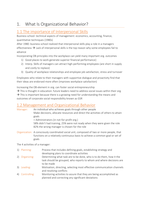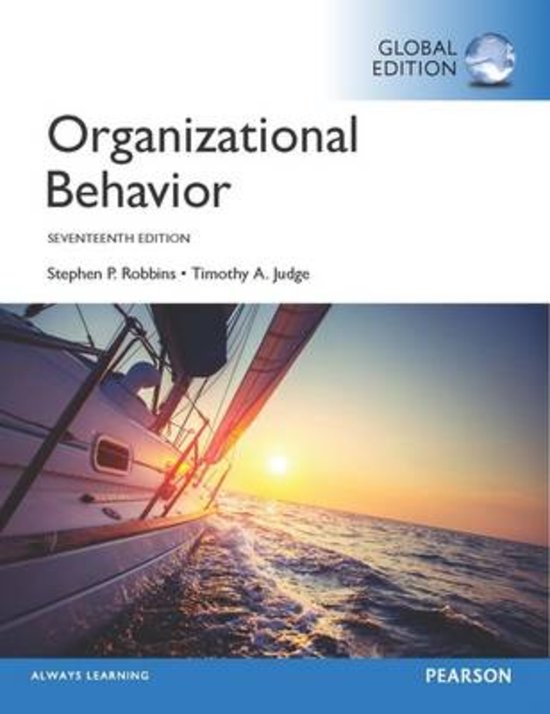1. What Is Organizational Behavior?
1.1 The importance of Interpersonal Skills
Business school: technical aspects of management: economics, accounting, finance,
quantitative techniques (1980s)
After 1980: business school realized that interpersonal skills play a role in a managers
effectiveness Lack of interpersonal skills is the top reason why some employees fail to
advance
Incorporating OB principles into the workplace can yield many important org. outcomes
1) Good places to work generate superior financial performance)
2) Interp. Skills of managers can attract high-performing employees (are short in supply
and costly to replace)
3) Quality of workplace relationships and employee job satisfaction, stress and turnover
Employees who relate to their managers with supportive dialogue and proactivity find that
their ideas are endorsed more often (improves workplace satisfaction)
Increasing the OB element in org. can foster social entrepreneurship
This is thought in education: future leaders need to address social issues within their org.
This is important because there is a growing need for understanding the means and
outcomes of corporate social responsibility known as GSR
1.2 Management and Organizational Behavior
Manager: An individual who achieves goals through other people
Make decisions, allocate resources and direct the activities of others to attain
goals
= Administrators (in not-for-profit org.)
58% didn’t had training, 25% were not ready when they were given the role
82% the wrong manager is chosen for the role
Organization: A consciously coordinated social unit, composed of two or more people, that
functions on a relatively continuous basis to achieve a common goal or set of
goals
The 4 activities of a manager:
1) Planning: Process that includes defining goals, establishing strategy and
developing plans to coordinate activities
2) Organizing: Determining what task are to be done, who is to do them, how it the
task should be grouped, who reports to whom and where decisions are
to be made
3) Leading: Motivation, directing, selecting most effective communication channels
and resolving conflicts
4) Controlling: Monitoring activities to assure that they are being accomplished as
planned and correcting any significant deviations
,1.2.1 Management roles
Ten roles primarily (1)
interpersonal, (2)
informational or (3)
decisional
1.2.2 Management skills
1) Technical skills: Ability to apply specialized knowledge or expertise
2) Human skills: Ability to work with, understand and motivate others, both individually
and in group
3) Conceptual skills: Mental ability to analyze and diagnose complex situations
1.2.3 Effective vs Successful Managerial Activities
1) Traditional management: Decision making, planning and controlling
2) Communication: Exchanging routine information and processing
paperwork
3) Human resource management: Motivating, disciplining, managing conflict, staffing and
training
4) Networking: Socializing, politicking and interacting with outsiders
, Successful: Defined in terms of
speed of promotion within their
org.
Networking largest
contribution, HRM the least
Effective: Defined in teams of
quantity and quality of their
performance and the
satisfaction and the
commitment of employees)
Communication largest
contribution, networking the least
Managers who explain their decisions and seek information form colleagues and employees
are the most effective (even when the information is negative)
Organizational behavior (OB): A field of study that investigates the impact that
individuals, groups, and structure have on behavior
within organizations, for the purpose of applying such
knowledge toward improving an organization’s
effectiveness.
Breakdown: It studies 3 determinants (indiv., groups and structure)
OB applies the knowledge gained about individuals,
groups, and the effect of structure on behavior in order
to make organizations work more effectively
OB is the study of what people do in an organization and how their behavior affects the
organization’s performance
Core topics of OB: Motivation, leader behavior, interpersonal com., group
structure and processes, attitude, chance processes,
conflict and negotiating, work design
1.3 Complementing Intuition with Systematic Study
Behavior is not random, we can identify fundamental consistencies underlying the behavior of
all individuals and modify them to reflect individual differences
These consistencies allow us to make predictions
Thus, behavior is predictable
Systematic study of behavior is a means to making reasonably accurate predictions
Systematic study: Looking at relationships, attempting to attribute causes and effects,
and drawing conclusions based on scientific evidence
,Scientific evidence: Data gathered under controlled conditions and measured and
interpreted in a rigorous manner
Evidence-based management (EBM): The basing of managerial decisions on the best
available scientific evidence
Intuition: A gut feeling not necessarily supported by research
We overestimate the accuracy of what we think we know
1.3.1 Big Data
Myth or science page 50 (read)
Background: Information became available for tracking (due the online shopping
trend)
Challenge for the companies: identify which statistics were persistent
and predictive (so they could make algorithms)
Current Usage: Reason for data analyses: predicting any event and preventing
catastrophes, predict user behavior curtailing risk
New Trends: Big data for understanding, helping and managing people
Limitations: Issues of privacy (electronic monitoring does increase task performance
and citizenship behavior, at least in the short term), human behavior is
not easy to predict, it has many variables
It is recommended to use evidence as much as possible to inform your intuition and
experience, that is the promise of OB
1.4 Disciplines that contribute to the OB field
OB is mainly based on psychology, social psychology, sociology and anthropology
Psychologie: Individual or micro level
Soc. psy., sociology and anthropology: Macro concepts (eg. Group processes and
organization)
1.4.1 Psychology
Psychology: The science that seeks to measure, explain, and
sometimes change the behavior of humans and
other animals
Contributors to OB: learning theorists, personality
theorists and I/O psychologists
Early I/O psychologists studied: Problems of fatigue, boredom, …
I/O now: Learning, perception, personality, emotions,
training, leadership effectiveness, needs and
, motivational forces, job satisfaction, decision-
making processes, performance appraisals,
attitude measurement, employee-selection
techniques, work design and job stress
1.4.2 Social Psychology
Social psychology: An area of psychology that blends concepts from
psychology and sociology and that focuses on the
influence of people on one another
One major study area is change: how to implement change and how to reduce barriers to its
acceptance
Also this area contribute to measuring, understanding an changing attitudes
And they also contribute to the study of group behavior, power and conflict
1.4.3 Sociology
Sociology: The study of people in relation to their social
environment or culture
Contribution through the study of group behavior in organizations, organizational culture,
organization theory and structure, communication, power and conflict
1.4.4 Anthropology
Anthropology: The study of societies to learn about human
beings and their activities
Studies on culture and environments, differences in fundamental values, attitudes and
behavior among people in different countries and within different organizations
Contribute to org. climate, org. culture and difference among national cultures
, 1.5 There Are Few Absolutes in OB
Human beings are complex
Because we are not alike, our ability to make simple, accurate, and sweeping generalizations
is limited
Two people often act very differently in the same situation, and the same person’s behavior
changes in different situations
This means that OB concepts must reflect situational or contingency conditions
We can say that x leads to y, but only under conditions specified in z (the contingency
variables)
Contingency variables: Situational factors: variables that moderate the relationship
between two or more variables
We’ll best understand OB when we realize how both (general effects and contingencies that
affect them) often guide behavior






